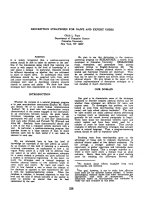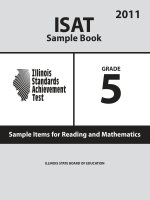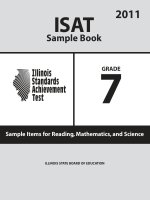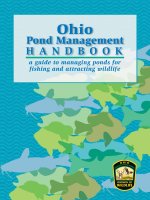ISAT Sample Book 4: Sample Items for Reading,Mathematics, and Science 2011 pot
Bạn đang xem bản rút gọn của tài liệu. Xem và tải ngay bản đầy đủ của tài liệu tại đây (4.69 MB, 107 trang )
ILLINOIS STATE BOARD OF EDUCATION
4
GRADE
ISAT
Sample Book
2011
Sample Items for Reading, Mathematics, and Science
IL523880_Gr4_SB 8/12/10 9:21 AM Page 1
Copyright © 2010 Illinois State Board of Education.
All rights reserved. This publication may be reproduced or transmitted by downloading and printing for
the purpose of practice testing and not for distribution or resale.
Portions of this work were previously published.
Stanford Achievement Test: Tenth Edition sample items used with permission of NCS Pearson, Inc.
“Swimming with the Pod” [Text & Illustrations]: Reprinted by permission of Cricket Magazine Group,
Carus Publishing Company from CLICK magazine February 2004, Vol. 7, No. 2, text © 2004 by Catherine
Ripley, art © 2004 by Diane Blasius.
IL523880_Gr4_SB 8/12/10 9:21 AM Page 2
2011 ISAT Grade 4 Sample Book
3
Table of Contents
Introduction 5
READING
Structure of the Grade 4 Reading ISAT 7
Item Formats 7
Reading Sessions 7
Shorter Passage Followed by Multiple-Choice Sample Items 8
Answer Key with Assessment Objectives Identified 11
Longer Passage Followed by Multiple-Choice Sample Items 12
Answer Key with Assessment Objectives Identified 18
Extended-Response Sample Item 19
Extended-Response Scoring Rubric 21
Annotated Extended-Response Student Samples 23
MATHEMATICS
Structure of the Grade 4 Mathematics ISAT 36
Item Formats 36
Answer Document for Grade 4 Mathematics ISAT 36
Mathematics Sessions 37
Calculator Use for Grade 4 Mathematics ISAT 37
Rulers for Grade 4 Mathematics ISAT 37
Scratch Paper for Grade 4 Mathematics ISAT 37
Multiple-Choice Sample Items 38
Answer Key with Assessment Objectives Identified 53
Short-Response Scoring Rubric 56
Using Short-Response Samples 57
Blank Short-Response Template 58
Short-Response Sample Items and Annotated Student Samples 59
Extended-Response Scoring Rubric 67
IL523880_Gr4_SB 8/12/10 9:21 AM Page 3
2011 ISAT Grade 4 Sample Book
4
Using Extended-Response Samples 69
Blank Extended-Response Template 70
Extended-Response Sample Items and Annotated Student Responses 72
SCIENCE
Structure of the Grade 4 Science ISAT 82
Item Format 82
Science Sessions 82
Cumulative Knowledge 82
Multiple-Choice Sample Items 83
Answer Key with Assessment Objectives Identified 103
IL523880_Gr4_SB 8/12/10 9:21 AM Page 4
2011 ISAT Grade 4 Sample Book
5
Introduction
This sample book contains sample ISAT items classified with an assessment objective from the Illinois
Assessment Frameworks. These 2011 samples are meant to give educators and students a general sense
of how items are formatted for ISAT. All 2011 ISAT test books will be printed in color. This sample book
does not cover the entire content of what may be assessed. Please refer to the Illinois Assessment
Frameworks for complete descriptions of the content to be assessed at each grade level and subject
area. The Illinois Assessment Frameworks are available online at www.isbe.net/assessment/IAFindex.htm
.
The Student Assessment website contains additional information about state testing
(www.isbe.net/assessment
).
IL523880_Gr4_SB 8/12/10 9:21 AM Page 5
6
Illinois Standards Achievement Test
Reading Samples
IL523880_Gr4_SB 8/12/10 9:21 AM Page 6
2011 ISAT Grade 4 Sample Book
7
Structure of the Grade 4 Reading ISAT
ISAT Reading testing in spring 2011 will consist of 30 norm-referenced items, as well as
criterion-referenced items. The 30 norm-referenced items are an abbreviated form of the Stanford 10
Reading assessment, developed by Pearson, Inc. The criterion-referenced items are all written by
Illinois educators and pilot tested with Illinois students.
Item Formats
All items are aligned to the Illinois Reading Assessment Framework, which defines the elements of the
Illinois Learning Standards that are suitable for state testing.
Multiple-choice items require students to read and reflect, and then to select the alternative that best
expresses what they believe the answer to be. A carefully constructed multiple-choice item can assess
any of the levels of complexity, from simple procedures to sophisticated concepts.
Extended-response items require students to demonstrate an understanding of a passage by explaining
key ideas using textual evidence and by using this information to draw conclusions or make
connections to other situations. The extended-response items are scored with a holistic rubric and count
as 10% of the scale score of the test.
Reading Sessions
All standard time administration test sessions are a minimum of 45 minutes in length. Any student who
is still actively engaged in testing when the 45 minutes have elapsed will be allowed up to an additional
10 minutes to complete that test session. More details about how to administer this extra time will
appear in the ISAT Test Administration Manual. This policy does not affect students who already receive
extended time as determined by their IEP.
Reading ISAT Grade 4
Session 1
45 minutes
6 shorter passages—30 multiple-choice items total
Session 2
45 minutes
Two longer passages consisting of:
1 expository passage with 10 multiple-choice items
1 literary passage with 10 multiple-choice items
1 extended-response item
Session 3
45 minutes
Consists of 2 or 3 passages
20 multiple-choice items
1 extended-response item
(Some items will be pilot items.)
IL523880_Gr4_SB 8/12/10 9:21 AM Page 7
8
Shorter Passage Followed by
Multiple-Choice Sample Items
IL523880_Gr4_SB 8/12/10 9:21 AM Page 8
9
GO ON
Reading
Summer Palace
by
Heidi Chang
“Here, Yeh Yeh (grandfather), I drew
another picture for you.”
“Ah, Sasha, you are getting so good
now,” her grandfather said. Sasha liked
to draw so much. She could spend hours
at the kitchen table drawing. Sasha
especially liked giving her drawings to
her grandfather.
Yeh Yeh hung all of Sasha’s pictures
in his study. It made Sasha feel special.
Her grandfather always found a place for
them.
“What is this drawing, Sasha?” her
yeh yeh asked, putting on his glasses
and looking closely. Sasha liked the way
her grandfather took time to talk about
her drawings.
“Well, that’s Dad coming home from
work and taking off his shoes,” Sasha
said.
“It’s very nice. I think I’ll put it here
right next to my books.” Sasha’s
grandfather had been a scholar in China
and had a lot of books. Many of them
were old and taped together. She knew
the story of when Yeh Yeh left China.
All he packed in his two suitcases were
books. Sasha knew how much Yeh Yeh’s
books meant to him. She was proud to
have her drawings hang above them.
“I’m glad you always like my
drawings, Yeh Yeh,” Sasha said.
“Your drawings are very special to me,
Sasha,” he said. “Do you know why?”
“Well, probably because I’m your
granddaughter,” she laughed.
“Yes, I suppose,” her grandfather
said, removing his glasses. He patted
Sasha on the head. “I never told you this
before because I thought you were too
young to understand. But your drawings
remind me of my father.”
“They do? Why?” she asked.
“Well, he was an artist. He came to
Beijing from a small village in China. He
was a young man at the time when they
were building Yi He Yuan, the Summer
Palace. He was one of the major
craftspeople who worked on it. It is a
famous garden in China and has some
of the most beautiful buildings.”
“Wow, Yeh Yeh. I didn’t know that,”
Sasha said. “He liked to draw, too?”
“Yes, Sasha. So you see, I am so glad
you like to draw. Every time you give me
a drawing, I think of my father.”
Sasha smiled and looked around at
all her pictures on the walls. She felt
happy to have given her grandfather so
many memories.
2011 ISAT Grade 4 Sample Book
IL523880_Gr4_SB 8/12/10 9:22 AM Page 9
10
Reading
2011 ISAT Grade 4 Sample Book
XEF244
1
Why hadn’t Yeh Yeh told
Sasha about the other artist in
the family before?
A He didn’t want to bore her with
old stories.
≥
B He thought she was too young
to understand.
C It made him sad to tell the
story.
D He was embarrassed about the
story.
XEF245
2
Sasha’s drawings and Yeh Yeh’s
books were alike because they
both —
A were handmade
B reminded Yeh Yeh of his
homeland
≥
C were treasures to Yeh Yeh
D had been especially made for
him
XEF247
3
This story is mainly about a —
A girl who likes to read
B grandfather who travels
C beautiful palace
≥
D girl learning about her
great-grandfather
XEF250
4
Which of these did the author
use in this story?
≥
A Dialogue
B Humor
C Rhyme
D Flashback
STOP
IL523880_Gr4_SB 8/12/10 9:22 AM Page 10
2011 ISAT Grade 4 Sample Book
11
To view all the reading assessment objectives, download the Illinois Reading Assessment Framework for
Grades 3–8 online at www.isbe.net/assessment/IAFindex.htm
.
Answer Key with Assessment Objectives Identified
Item
Number
Correct
Answer
Assessment Objective
Shorter Passage
1B
1.4.17 Determine the answer to a literal or simple inference question
regarding the meaning of a passage.
2C
1.4.22 Draw inferences, conclusions, or generalizations about text, and
support them with textual evidence and prior knowledge.
3D
1.4.19 Identify the main idea of a selection when it is not explicitly stated
(e.g., by choosing the best alternative title from among several suggested
for a given passage).
4A
1.4.22 Draw inferences, conclusions, or generalizations about text, and
support them with textual evidence and prior knowledge.
IL523880_Gr4_SB 8/12/10 9:22 AM Page 11
12
Longer Passage Followed by
Multiple-Choice Sample Items
IL523880_Gr4_SB 8/12/10 9:22 AM Page 12
13
GO ON
Reading
2011 ISAT Grade 4 Sample Book
This is a passage about how giant orca whales live together and care for each other.
by Catherine Ripley
1 PFFFFF! Splash! A six-year-old male orca whale surfaces, shooting a big spray of
stale air from the blowhole on top of his head. For several minutes he and his
family slice slowly through the ocean waves, breathing deeply, filling their large
lungs with air. Then, side by side, the orcas dive.
2 The male is the youngest and swims close to his mom. To their left is his uncle
and in front, leading them all, is his grandmother. A second uncle swims nearby.
And just beyond him are two more families in the pod, which is the name for a
group of whales. The 16 whales in this pod live together in Johnstone Strait, on
the northwest coast of Canada.
3 Most orcas stay with the pod they are born into for their whole lives. As an
infant, the young male swam beneath his mother’s belly, where he was safe and
could nurse easily. When he was born, his mother probably helped him to the
surface to take his first breath. Whales need air, just like people, or they will
drown. Sometimes the pod might even help an injured whale come up to the
surface for air.
4 When orcas are not searching for food, they like to “talk” and socialize — even
play! They roll and splash in the salty water, and they call to each other.
Scr-eee-CH! Whistle! Whistle!
IL523880_Gr4_SB 8/12/10 9:22 AM Page 13
14
GO ON
Reading
2011 ISAT Grade 4 Sample Book
5 The young male spyhops. He punches his head and upper body above the water
and looks around. He sees a female cousin breach the waves. She throws her body
almost completely out of the water and crashes down again. KERSPLASH! Another
cousin swims sideways and smacks her flipper playfully against the water. SLAP!
6 Now Grandmother is speeding toward shore and the family follows. She rubs
her massive body through the smooth rounded rocks on the bottom of the bay.
Mom goes next and the young male follows. The family spends the next
hour “beach rubbing.” Scientists think this feels good to orcas
and may help keep their skin clean.
7 But most of the pod’s day is spent finding food. The
whales spread out and send out a series of fast clicks as
they swim down the bay together. Click, click, click!
The orcas can tell from the way their clicks echo
through the water if a school of salmon is nearby!
8 Some orcas hunt seals, sea lions, and porpoises,
instead of fish. They live in small groups and are
silent when they hunt. No chatting allowed! Their
prey might be listening!
9 But the young male’s pod eats mainly
salmon. The whales use many calls to stay
in touch as they hunt. “Wee-oo-uuo,”
cries a cousin from across the bay.
IL523880_Gr4_SB 8/12/10 9:22 AM Page 14
15
GO ON
Reading
2011 ISAT Grade 4 Sample Book
“Wee-oo-uuo,” answers Grandmother. “Squ-eee-AL, CRe-e-e-eak,” calls Mom. Each
pod “speaks” slightly differently from the next, and scientists can recognize a
particular pod by the sounds its whales make.
10 Soon the orcas’ bellies are tight with salmon. It is time for a rest. Orcas cannot
sleep under the water. They must come to the surface every few minutes to
breathe. So they cruise slowly forward, diving, then surfacing for air, in a regular
resting pattern that can last for hours. Swimming together, the young whale and
his family surface, breathe, and dive . . . surface, breathe, and dive . . . ZZZZZZ!
1
As an infant, the orca swims
under his mother. Which
means the opposite of infant?
A Teen
B Baby
C Child
D Adult
2
According to paragraph 5,
what is a young orca doing
when he spyhops?
A He is getting ready to eat.
B He is waiting for his mother.
C He is talking with his cousins.
D He is checking out his
surroundings.
3
What does the word breach
mean in this sentence from
the passage?
“He sees a female cousin
breach the waves.”
A Break through
B Dive deep into
C Punch down into
D Swim sideways through
4
In the passage, KERSPLASH,
SLAP, and ZZZZZZ are
examples of —
A rhyme.
B alliteration.
C consonance.
D onomatopoeia.
IL523880_Gr4_SB 8/12/10 9:22 AM Page 15
16
GO ON
Reading
2011 ISAT Grade 4 Sample Book
5
According to the passage, which of these goes in the empty box?
A Mom rubs on the smooth rocks.
B Uncle is the last one to “beach rub.”
C The cousins rub on rocks next to the young male.
D The young male follows his cousins to “beach rub.”
Grandmother orca
leads her family
toward the shore.
Grandmother orca
rubs on the
smooth rocks.
The family spends
about an hour
“beach rubbing.”
6
Which of the following describes the correct order of the passage?
A Playing → Sleeping → Breathing → Hunting
B Breathing → Playing → Hunting → Sleeping
C Sleeping → Hunting → Playing → Breathing
D Hunting → Breathing → Sleeping → Playing
7
What is the base word of
differently?
A diff
B differ
C differen
D different
IL523880_Gr4_SB 8/12/10 9:22 AM Page 16
17
Reading
2011 ISAT Grade 4 Sample Book
STOP
8
What was the author’s purpose
in writing this passage?
A To inform
B To entertain
C To complain
D To persuade
9
Which of these is another
good title for this passage?
A “Sleeping in the Ocean”
B “The Underwater Silence”
C “A Different Kind of Family”
D “Fish of the Northwest Coast”
10
Where would the reader most
likely find this passage?
A A journal
B A story book
C A nature magazine
D A science fiction book
IL523880_Gr4_SB 8/12/10 9:22 AM Page 17
2011 ISAT Grade 4 Sample Book
18
Answer Key with Assessment Objectives Identified
Item
Number
Correct
Answer
Assessment Objective
Longer Passage with Multiple-Choice Items
1D
1.4.06 Use antonyms to define words.
2D
1.4.04 Determine the meaning of an unknown word using word,
sentence, and cross-sentence clues.
3A
1.4.05 Use synonyms to define words.
4D
2.4.12 Identify examples of poetic devices using sound,
(e.g., alliteration, onomatopoeia, rhyme scheme, consonance).
5A
1.4.21 Identify or summarize the order of events in a story.
6B
1.4.21 Identify or summarize the order of events in a story.
7D
1.4.01 Determine the meaning of an unknown word using knowledge of
common prefixes, suffixes, and word roots (see Roots and Affixes list) (e.g.,
using knowledge of the suffix -ish to determine the meaning of foolish).
8 A
1.4.26 Identify the author's purpose for writing a fiction or nonfiction text
(e.g., to entertain, to inform, to persuade).
9C
1.4.19 Identify the main idea of a selection when it is not explicitly stated
(e.g., by choosing the best alternative title from among several suggested
for a given passage).
10 C
1.4.26 Identify the author's purpose for writing a fiction or nonfiction text
(e.g., to entertain, to inform, to persuade).
To view all the reading assessment objectives, download the Illinois Reading Assessment Framework for
Grades 3–8 online at www.isbe.net/assessment/IAFindex.htm
.
IL523880_Gr4_SB 8/12/10 9:22 AM Page 18
19
Extended-Response Sample Item
IL523880_Gr4_SB 8/12/10 9:22 AM Page 19
20
Reading
2011 ISAT Grade 4 Sample Book
Assessment Objective: 1.4.22 Draw inferences, conclusions, or generalizations about text, and
support them with textual evidence and prior knowledge.
STOP
1
How is an orca family similar to a human family? Use information from the
passage and your own ideas and conclusions to support your answer.
IL523880_Gr4_SB 8/12/10 9:22 AM Page 20
21
Extended-Response
Scoring Rubric
IL523880_Gr4_SB 8/12/10 9:22 AM Page 21
2011 ISAT Grade 4 Sample Book
22
Reading Extended-Response Scoring Rubric
Readers identify important information found explicitly and implicitly in the text. Readers use this
information to interpret the text and/or make connections to other situations or contexts through
analysis, evaluation, or comparison/contrast. A student-friendly version of this extended-response rubric
is available online at www.isbe.net/assessment/r
eading.htm.
CriteriaScore
4
• Reader demonstrates an accurate understanding of important information in the text by focusing on the key ideas presented
explicitly and implicitly.
• Reader uses information from the text to interpret significant concepts or make connections to other situations or contexts logically
through analysis, evaluation, inference, or comparison/contrast.
• Reader uses relevant and accurate references; most are specific and fully supported.
• Reader integrates interpretation of the text with text-based support (balanced).
3
• Reader demonstrates an accurate understanding of information in the text by focusing on some key ideas presented explicitly and
implicitly.
• Reader uses information from the text to interpret significant concepts or make connections to other situations or contexts logically
(with some gaps) through analysis, evaluation, inference, or comparison/contrast.
• Reader uses relevant and accurate references; some are specific; some may be general and not fully supported.
• Reader partially integrates interpretation of the text with text-based support.
2
• Reader demonstrates an accurate but limited understanding of the text.
• Reader uses information from the text to make simplistic interpretations of the text without using significant concepts or by making
only limited connections to other situations or contexts.
• Reader uses irrelevant or limited references.
• Reader generalizes without illustrating key ideas; may have gaps.
1
• Reader demonstrates little or no understanding of the text; may be inaccurate.
• Reader makes little or no interpretation of the text.
• Reader uses no references, or the references are inaccurate.
• Reader’s response is insufficient to show that criteria are met.
0
• Reader’s response is absent or does not address the task.
• Reader’s response is insufficient to show that criteria are met.
IL523880_Gr4_SB 8/12/10 9:22 AM Page 22
2011 ISAT Grade 4 Sample Book
23
Grade: 4 Sample: 1 Score: 2
Make sure you
– Read the question completely before you start to write your
answer,
– Write your answer to the question in your own words,
– Write as clearly as you can so that another person can read
your answer and understand what you were thinking,
– Read over your answer to see if you need to rewrite any
part of it.
DI RECTIONS
*This response demonstrates an accurate but limited understanding of the text. The reader makes some
simple comparisons. The reader uses text references without providing any interpretation of significant
concepts.
IL523880_Gr4_SB 8/12/10 9:22 AM Page 23
2011 ISAT Grade 4 Sample Book
24
Grade: 4 Sample: 2 Score: 2
Make sure you
– Read the question completely before you start to write your
answer,
– Write your answer to the question in your own words,
– Write as clearly as you can so that another person can read
your answer and understand what you were thinking,
– Read over your answer to see if you need to rewrite any
part of it.
DI RECTIONS
IL523880_Gr4_SB 8/12/10 9:22 AM Page 24
2011 ISAT Grade 4 Sample Book
25
*This response demonstrates an accurate but limited understanding of the text. The reader makes some
simple comparisons. The reader uses text references without providing any interpretation.
IL523880_Gr4_SB 8/12/10 9:22 AM Page 25









